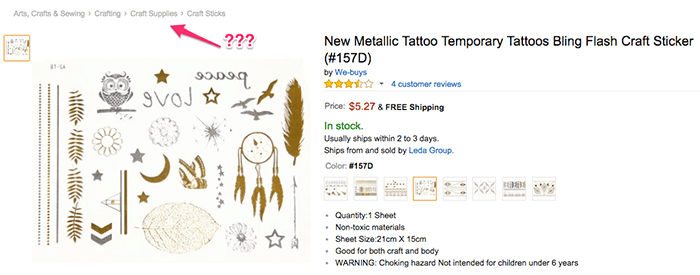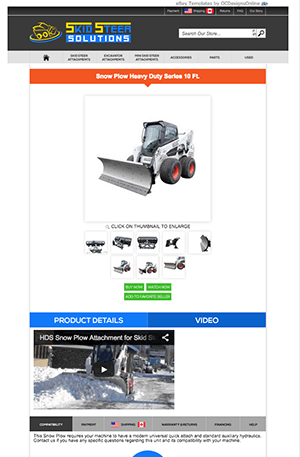In my last post, I explored how selling on marketplaces can be more profitable than selling on your own store. For the sake of being thorough, and fairly representing both sides of the equation, let’s look at a key reason why selling on your own store is more advantageous than selling on marketplaces.
I realized this was necessary after reading a very thoughtful comment left by a reader on the last post:
Missed probably the most important reason to have your own website if you do a lot of marketplace selling – the life jacket (aka insurance). There are horror stories out there of sellers getting kicked off of both venues for things completely out of their control…
The reader goes on to mention situations that can occur that result in losing your selling privileges: getting accused of selling counterfeit goods, having a supplier pull your best selling line from the marketplaces, or having Amazon block access to a line of products at the request of the manufacturer.
The point highlighted by this reader is lack of control. Let me paint a picture for you:
You are a highly successful pet supplies seller on Amazon. You’ve got thousands of products, and have revenues of a few hundred thousand dollars every month. You’re products are all fulfilled by Amazon, so you don’t have to worry about inventory, and you benefit from Amazon’s free shipping.
Note: I’m using Amazon in this example, but it could theoretically be any marketplace.
Things are running along pretty smoothly, until one of the situations mentioned above comes up.
If something like that does happen, it can spell doom for sellers, since Amazon blindly sides with manufacturers and customers – and doesn’t really pay much attention to sellers aside from letting them use the platform.
So to boil it all down, stores can be more advantageous than marketplaces because of one simple factor: control.
What kind of control?
We’ve all heard horror stories about bosses that are control freaks, right? And conventional wisdom always says to let go of the reigns a little bit and not micromanage. We’re not really talking about that kind of control though; when we say “control” your business, what kind of control do we really mean?
Top-level control
At the end of the day, your business should still be YOUR business, and you want to keep it that way.
On marketplaces, the unspoken price you pay for piggybacking on their infrastructure, traffic, and trust is that you are relinquishing nearly all control from your business.
Ultimately, it’s the marketplace’s decision – not yours – whether or not you can even continue to sell or not. If someone files a complaint, or you run into a few tough, disgruntled customers, you could be toast.
Mid-level control
Mid-level control is over the types of products you can list for sale, what categories you put them in, and other broad product/category level details.
Some marketplaces like eBay have very, very detailed product taxonomies and let you list pretty much anywhere you like.
However others, like Amazon, may have the detailed taxonomies but they won’t let you put your products just about anywhere. If the product you are selling is already in the Amazon catalog, you’ll have to list your offering in the same product – and while this is not usually a problem, sometimes, the listings are really out of whack.

eBay is also pretty liberal with what you can sell online. Aside from a few things you should definitely not be selling anyway, you can get away with selling almost anything there.
Amazon, again, is much tougher. Since Ebay is actually just a medium for sellers and buyers to interact, they don’t really care if the products are fake or real.
Amazon has to be a lot more careful, since even third party sellers are still selling “from Amazon”, so a few lucrative categories such as jewelry and apparel are restricted. Of course, you can apply to have restrictions removed from your account, but that goes back to the control problem – if they can lift restrictions from your account, they can as easily put them back.
Low-level control
This is the sort of stuff some people would consider to be “micro-managing.” Since this is ecommerce we are talking about, it never hurts to be too detail-oriented, so let’s get to it.

These details are the finer points – what you charge for shipping, what images you use, and the product description itself. eBay is pretty liberal and flexible here, offering the option for custom HTML templates and embedded YouTube videos in your description.
Amazon is tough – since it’s highly likely someone is already selling the same product you are, you’ll have to stick with their images and their descriptions. You can add your own, but whether or not Amazon will post that to the listing is their choice, and often not attended to.
Shipping charges are also pre-set by Amazon, although you can set a standard base price. Amazon will then increase on top of that. Ebay has recently added a feature where they’ll determine the shipping for you based on your zip code and the buyer’s zip code, which isn’t such a bad feature.
There’s one more glaring loss of control with Amazon (and a little with Ebay)
And that’s control of your money! Your precious money, the stuff you’ve worked so hard to earn. eBay first: since your transactions are processed by PayPal, your money probably collects in PayPal for a few days before you withdraw it, and even then, it takes 2-3 days for it to show up in your bank account.
There have also been horror stories of PayPal accounts being frozen for “suspicious activity” and never being opened again – sometimes resulting in the loss of all the funds that were not yet withdrawn. Don’t let this scare you away from opening your eBay store if that’s a goal, I’m just saying… it’s happened.
The same thing goes for Amazon – they hold on to your funds, and they have a regular remittance cycle in which they disburse the funds to your account. This may not seem like too big a deal until you start dealing in serious volume. Imagine having tens of thousands of dollars of revenue that Amazon holds for a while before remitting it to you – and if anything goes south in the meantime, they’ll be quick to shut you down.
That’s not how it’s going to be with your own site and merchant account. Here, you’ll get your funds fairly regularly(again depending on volume), but the difference here is that your credit card processor is not in direct contact with your buyer, unlike Ebay and Amazon.
In conclusion…
At the end of the day, the lesson to be learned is to have and build a presence on all channels. Think of it as a pair of legs – one leg is marketplaces, and the other is your store. If one gets jeopardized for whatever reason, you’ll still have support.
We’ve written some great posts in the past about how to build your branded presence through your Ebay and Amazon selling, make sure to give them a read!


